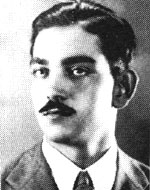Son of Rivka and Eliezer Habib (Lieblich). He was born on July 18, 1926 in Haifa, and moved to Jerusalem at the end of 1926. He studied at the Tachkemoni Elementary School and at the Beit Hakerem High School in Jerusalem, where he excelled in his studies and devoted himself to activities such as reading , Writing, drawing, collecting flowers and traveling in Israel, and in his parents’ home he received a traditional education, was observant and at an early age connected his religious faith to Zionist belief in the establishment of the Hebrew state. The people of Israel to the Land of Israel and they will settle here on both sides of the Jordan. At the time of this mikveh there will be a Hebrew state like all the other nations. Amen. Yes, may it be. “At the age of 15, he joined the Irgun Zvai Leumi (National Military Organization), first for the youth battalions and later for the Chatam (Revolutionary Propaganda Corps). In the underground he stood out for his devotion and seriousness, and as a friend testified, “he had the seriousness of an adult, he was known for his firmness and was not deterred by any difficulty. His friends are also known for his well-developed sense of justice and the peace of his speech. After graduating from high school, he chose to join the “Palmach” (the Palmach’s battalions), where he was trained in military training, developed his physical fitness and even completed a course for sports instructors. Including the release of the Ma’apilim from the Atlit camp (October 9, 1945). About a month later, he returned to Jerusalem to begin his university studies in Hebrew language and literature circles as well as history, philosophy and economics. At the same time he renewed his activity in the Irgun and joined the Fighting Force. He specialized as a machine gunner, passed a commanders’ course, and received the rank of “head of a group.” He later took part in several daring attack operations, and in an attack on the officers’ club at Goldschmidt House (March 1, 1947), the Bren machinegun raised the British reinforcements it felt. He was burned in his hand but did not abandon his position until the end of the operation. He also participated in mining British cars on the Jerusalem-Bethlehem road, attempting to break into the Jerusalem prison to rescue underground prisoners (January 20, 1946) and more. On May 4, 1947, he participated in the famous Acre prison break as commander of Unit 3, whose task was to make the road from Acre’s local police to the fortress, and to attack the prison guard in the southeastern wall. During the operation, Haviv and his two comrades in the unit – Meir Nakar and Yaakov Weiss – threw grenades at the police station until they abandoned their positions and the prison remained without guards. However, the three men were discovered on the way to the retreat and after the exchange of fire they were captured by the British soldiers. On May 8, 1947, the three were brought to trial in Jerusalem but refused to recognize the British court and its authority to try them and made political statements before their judges. In his statement, Avshalom said among other things: “Neither the handlebars nor the intrigues have the power to stand against the soul of man for a long time, against the soul of the free man, for this soul will bring forth wonders, it will break the bayonets, it will break up intrigues. Even if you take away the transient body. ” The judgment against Avshalom and his comrades for action – death by hanging – was given on June 16, 1947, and on 8 July was approved by the army commander. On July 9, 1947, he wrote to his girlfriend outside: “I see the clothes in which I am dressed and know very well what they mean … I know that death has four simple steps: there is a door in the corridor that will not be opened.” On the 29th of Av 5747 (29.7.1947), at 4 AM, Avshalom strode upright toward the gallows while singing Hatikva on his lips. After him, Nakar and Weiss were hanged and all three were brought to eternal rest in the Safed cemetery near KThe victims of the 1929 riots and their four underground comrades who were raised to the gallows were Dov Gruner, Mordechai Elkachi, Eliezer Kashani and Yehiel Dresner. Avshalom Haviv was promoted to sergeant. The chapters of his life and deeds are commemorated in the books “Four Steps to Death”, in which his letters are from the gallows cell; “Remembering Eternity”, Yizkor Book of Heroes of the Irgun Zvai Leumi; “The Book of Olei HaGardom” to me. Nadavah, “The victory over me gallows” to me. Gurion University and others.
